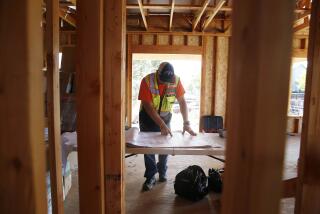Q&A;: NICOLAS P. RETSINAS : Housing Agency in the Midst of a Refurbishing
- Share via
Over the last several years, the Federal Housing Administration has been in the middle of a major transition. Created in 1934 to address the Depression-era collapse of the private mortgage insurance industry, the FHA gave government backing to home loans in an effort to encourage reluctant lenders to issue mortgages.
After the mortgage insurance market recovered, the FHA evolved into a program to serve people who are “shut out and left out” of the home-buying process because of their income, race or where they choose to live. The program now ensures low-down-payment mortgages and sponsors new products to assist lower-income individuals buy or refurbish homes.
But, under fire for being too costly and too burdensome, the agency recently opted to revamp itself to make its products less expensive and more accessible to millions of additional home buyers.
Under the leadership of Nicolas P. Retsinas, assistant secretary with the U.S. Department of Housing and Urban Development, the agency will also play a pivotal role in President Clinton’s recent promise to boost homeownership to all-time highs by the end of the decade.
While touring the country to promote a series of new and improved government housing programs, Retsinas took a few minutes out to discuss the FHA’s future and how consumers can benefit from the agency’s new approach.
Q. What is President Clinton’s homeownership goal and how will HUD and the FHA be involved in trying to meet it?
A. President Clinton . . . wants to achieve a record home ownership rate of 67.5% by the year 2000, from about 64.5% today. That would put 8 million more Americans into their own homes.
The only way we can achieve that is to increase home ownership among minorities. Right now, about 70% of the white population are homeowners, but homeownership is 43% among African Americans and just 40% among Hispanics. If we are going to make the American dream a reality, we have to decrease that disparity.
****
Q. Aside from offering mortgage insurance, what exactly are you doing now to increase homeownership?
A. One of the biggest barriers to buying a home are the high closing costs. We are working on reducing closing costs, which will have the ultimate effect of putting more money in the pockets of home buyers.
****
Q. How do you do that?
A. The FHA has lowered its insurance premiums by about 25% and we also changed our rules to allow lenders to use their own appraisers, rather than a panel of appraisers put together by the FHA. The savings on that change alone range from $50 to $100. The Department of Housing and Urban Development also changed the way that escrow payments are calculated. The new rules are going to save consumers about $200.
But there’s no magic wand. We need to look at all the services that are now a part of the traditional closing--appraisal costs, title and legal fees--and ask, are the fees appropriate? Can we save money with automation? Maybe we can reduce costs by buying services on a bulk basis.
****
Q. Recently a lot of lenders have started programs to cater to low-income, inner-city and first-time home buyers, but I suspect that’s partly because the market for traditional loans is slow. Are lenders going to abandon these borrowers as soon as loan demand starts picking up again?
A. I don’t think so. Clearly there is added impetus to lend when there is a contracting market. But I think lenders are going to find that this is good business. The FHA program is proof of it. Last year, we had our 61st profitable year in a row. They’ll stay in the market because lending to low-down-payment borrowers can be not only self-sustaining, it can be profitable.
****
Q. What practical tips would you offer to first-time borrowers or people who have had problems finding a mortgage loan in the past?
A. I would emphasize not to rule yourself out. A lot of people do. They think, “I’m not ready to buy. I can’t afford it.” They turn themselves down before they ever start.
Look into housing counseling. That’s developed substantially, with many communities offering housing counseling programs. Keep track of your bills. Talk to your realtor. Talk to your lender.
Believe that it can be done. Homeownership works in this country and there are a lot of long-run benefits.
Fifteen or 20 years from now, you may use the equity in your home to send the kids to college or to retire. The prognosis is positive.
More to Read
Inside the business of entertainment
The Wide Shot brings you news, analysis and insights on everything from streaming wars to production — and what it all means for the future.
You may occasionally receive promotional content from the Los Angeles Times.










